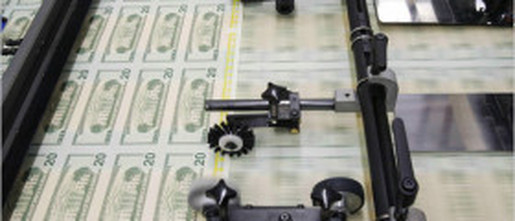The production of a new bill begins when artists sketch their designs for it. The secretary of the treasury must approve the final design. Engravers cut the design into a steel plate. A machine called a transfer press squeezes the engraving against a soft steel roller, making a raised design on its surface. After the roller is heat-treated to harden it, another transfer press reproduces the design from the roller 32 times on a printing plate. Each plate prints a sheet of 32 bills. Separate plates print the two sides of the bills.
Many people believe the paper used for money is made b a secret process. But the government publishes a detailed description of the paper so private companies can compete for the contract to manufacture it. A U.S. law forbids unauthorized people to make any type of paper similar to that used for money.
The Bureau of Engraving and Printing uses high speed presses to print sheets of paper currency. The design is printed first. Then the seals and serial numbers are added. The sheets are cut into stacks of bills. Imperfect bills are replaced with new ones called star notes. Each star note has the same serial number as the bill it replaces, but a star after the number shows that it is a replaces, but a star after the number shows that it is a replacement bill. The bills are shipped to Reserve Banks, which distribution them to commercial banks.
Most $1 bills wear out after about 18 month in circulation. Larger denominations last for years because they are handled less often. Banks collect worn-out bills and ship them of Federal Reserve Banks for replacement. The Reserve Banks destroy worn-out money in shredding machines.
Many people believe the paper used for money is made b a secret process. But the government publishes a detailed description of the paper so private companies can compete for the contract to manufacture it. A U.S. law forbids unauthorized people to make any type of paper similar to that used for money.
The Bureau of Engraving and Printing uses high speed presses to print sheets of paper currency. The design is printed first. Then the seals and serial numbers are added. The sheets are cut into stacks of bills. Imperfect bills are replaced with new ones called star notes. Each star note has the same serial number as the bill it replaces, but a star after the number shows that it is a replaces, but a star after the number shows that it is a replacement bill. The bills are shipped to Reserve Banks, which distribution them to commercial banks.
Most $1 bills wear out after about 18 month in circulation. Larger denominations last for years because they are handled less often. Banks collect worn-out bills and ship them of Federal Reserve Banks for replacement. The Reserve Banks destroy worn-out money in shredding machines.

 RSS Feed
RSS Feed